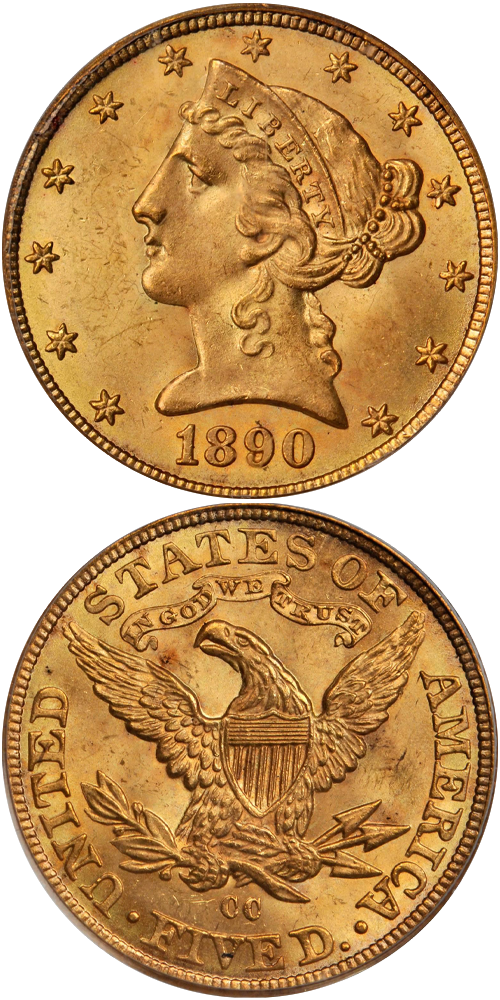1890-CC Liberty Head Half Eagle
Jeff Ambio: The only known die marriage for this issue exhibits a large date that is well centered between the base of Liberty's portrait and the denticles. On the reverse, the CC mintmark is tall and closely spaced with the first C slightly higher than the second.
Rusty Goe: During the Carson Mint's more than five-year suspension of half eagle coinage (1885-1890), the ratio in outputs between large double eagles and smaller half eagles (and eagles) had fluctuated. Clearly, the Treasury had faced challenges in its attempts to stabilize the nation's monetary system.
In his 1890 annual report, Mint Director Edwin O. Leech talked about the "heavy drain of gold from the United States." He said it was detrimental to the U.S. "to be placed in a position where it is ... powerless to stop a serious drain on the gold stock of the country...." He urged Congress to repeal the law that allowed any person or entity to exchange gold coin for gold bars.
Others had felt threatened that certain European nations had put in motion, starting in the 1880s, a plan to raid the gold reserves of the U.S. And some believed that the banking monopoly on the East Coast had conspired to control the nation's gold supply, and that the government had facilitated the bankers' plan by issuing Treasury Notes in payment for the silver bullion that the new Sherman Silver Law mandated be purchased at the rate of 4.5 million ounces monthly. The wording in the law left it to the Treasury Secretary's discretion to redeem the notes in silver or gold coin.
In Carson City, workers at the mint were just happy to have jobs. The Daily Nevada State Journal of April 6, 1890, said, "Charles Colburn took charge of the coining department of the Mint [in late 1889] without any previous experience, but he went in with a determination to win." Although he had concentrated on silver dollars and double eagles in the first six months of 1890, between July and December Colburn stamped out 53,800 half eagles. This compared to the Philadelphia Mint's figure of 4,240, with no examples of this denomination having come out of San Francisco (the New Orleans Mint had not struck any since before the Civil War, and would not again until 1892).
Q. David Bowers: I estimate that there are from 250 to slightly over 400 1890-CC half eagles in circulated grades from VF to AU, including many AU. For Mint State I estimate at least 150, possibly even slightly over 250. Rusty Goe's estimates are more liberal, A few Gems are known. Most were repatriated from overseas in the late 20th century, reflecting that modest quantities of half eagles were exported at the time.
In the 1930s New York City dealer Thomas L. Elder sent lists of gold coins to bankers and others who were receiving large quantities being turned in by the general public in response to President Roosevelt's demands. Elder saved countless thousands of scarce and rare varieties from destruction.
The example to the left was sold by Stack's Bowers Galleries in the August 2012 Battle Born Collection of Carson City Coinage, where it realized $47,000.






